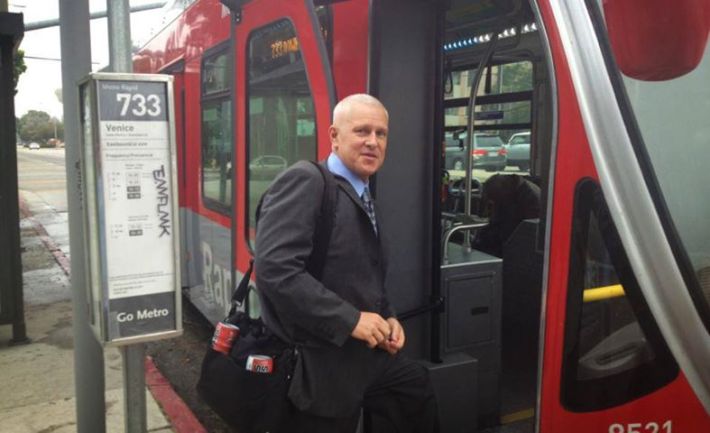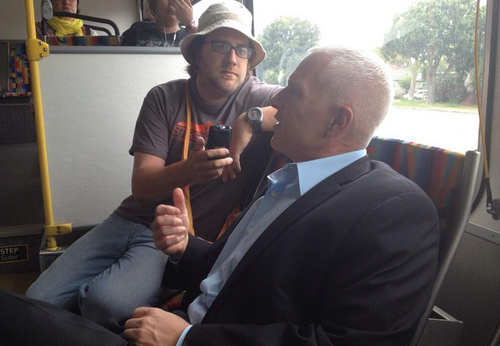(Editor's note: We're breaking out interview with new Los Angeles City Council Transportation Committee Chair Mike Bonin into three parts. Today will focus on his role as Chair. Tomorrow will focus on local issues on the Westside's CD 11. Monday we will post the unedited audio from the interview.)
“Hello, my name is Mike and I want to listen to you. And I mean genuinely listen to you.”
When I asked City Council Member, and newly minted Transportation Committee Chair, Mike Bonin what his opening line to transportation advocates, he responded with this simple line.
Whether the city has turned a corner to embracing a truly multi-modal transportation network, or whether the victories of the last couple of years are hiccups and Los Angeles will return to its car-centric history depends a lot on the decisions that Bonin and the Transportation Committee make over the next four years. So when we sat down last week, it was the little things that we looked for. We already knew he could talk the Livable Streets talk. We also know what really matters is if he can walk the Livable Streets walk.
The early returns are good.
Not only did he and his staff insist that we do the interview on the 733 Metro Rapid Line that connects the Westside and Downtown Los Angeles on Venice Boulevard, the choice of the bus wasn't just for show. The 733 was how he was going to work that day, to meetings in his office before walking to a meeting for the Expo Construction Authority Board of Directors. To top it off, he walked to the bus stop from the Mar Vista home he shares with his partner, Sean Arian.
“I want to hit a reset button," Bonin responded to my very first question. "I don’t want this to just be Bill’s third term, but a fresh look at stuff.”
For a man who has spent the last eight years working as the Chief of Staff for a popular City Council Member, Bonin is emphasizing that now is the perfect time for both the West Los Angeles Council District he represents and the city as a whole to take a fresh look at the problems and opportunities that face their communities. In fact, one of Bonin's first acts as Council Member-Elect was to meet with planners and leaders in neighboring Santa Monica to start talking about ways the neighboring cities can work together on transportation issues.
But while building, or re-building, relationships with neighboring city leaders is important; Bonin recognizes that the sharpest challenge in changing the way Angelenos think about transportation is changing the way make their choices.
“I want every Angeleno to try transit at least once," Bonin said, shortly after chatting briefly with a constituent that recognized him and wanted to say hi. Streetsblog always asks our interviewees what they would do if they could wave a magic wand and change one thing about transportation. Candidate Bonin and Council Member Bonin gave the same answer. Convince everyone to try transit just once.
But it needs to be a process of convincing, not forcing.
“There’s been a movement in transportation to try and punish people into good behavior," he explains. "You also need measures that will pull people and incentivize people the best way to do that is to make it convenient and make it safe.”
At the core of this is the belief that once people try riding the bus or train, using their bicycle, or walking down the street, that they will continue doing it. "Not everyone will change over, but many will."
And how does a city incentivize walking and bicycling? By building networks that make sense from a transportation standpoint and are perceived as high-quality and safe. When asked what he would like his legacy as transportation chair to be, Bonin focused on three areas: building out the bicycle plan, making sure the city has the finances to rebuild sidewalks and road crossings for pedestrians, and changing the mitigations the city requires for new developments.
When building, or rebuilding, a bicycle and pedestrian network, Bonin claims the focus should be on building the highest quality system, not in building as much infrastructure as possible.
"(We need to) identify projects first that are most essential and least controversial," Bonin said of the city's bicycle plan. "We can do quality or we can do fast. I want us to do quality. I don’t want to slap down a bunch of Sharrows to increase quantity, we want to build bigger projects, such as protected bike lanes.”
“There’s more interest than willingness to use our bike system in Los Angeles right now. If we can demonstrate that bike lanes are safe, fun and convenient, than we can get those people to try.”
But perhaps a bigger issue, since the city seems to be building out its bicycle and pedestrian systems, is the third focus area: coming up with better mitigation plans.
"I don’t know that there’s a major or medium development project where the community feels the mitigation is adequate," Bonin continues. He proposes looking at the impacts developments have on local residents and businesses as well as the broader transportation network. For example, a developer might be required to build an extra turning lane for mixed use travel to improve regional traffic flow. However, that does little for a local resident who wants or needs to get to the store, especially if they are on foot. In fact, the additional turning lane might make things more difficult.
Instead a shuttle program would be a better system, for the people most impacted by new development.
But this is going to be a larger project, one that would end with a major City Council vote after hearings and outreach.
The good news is, Bonin is planning to do a lot of listening. To make any changes in the way the city works with developers over mitigation, he's going to need to.









